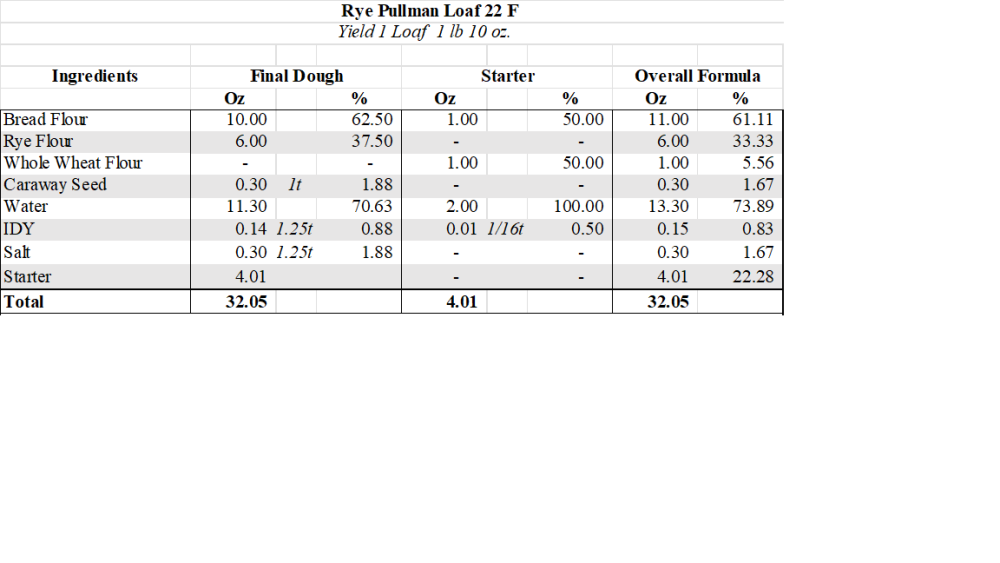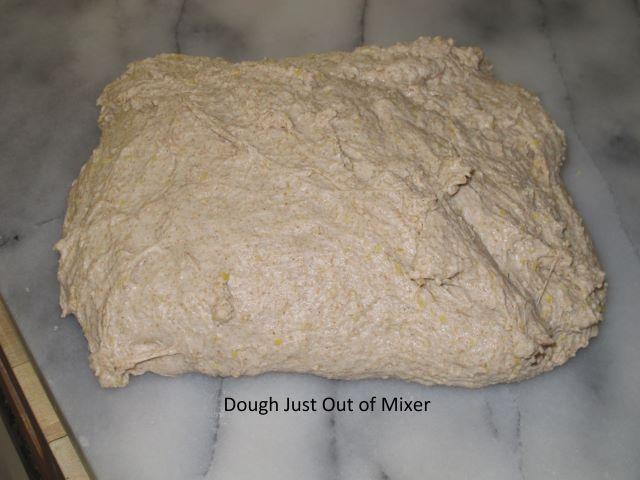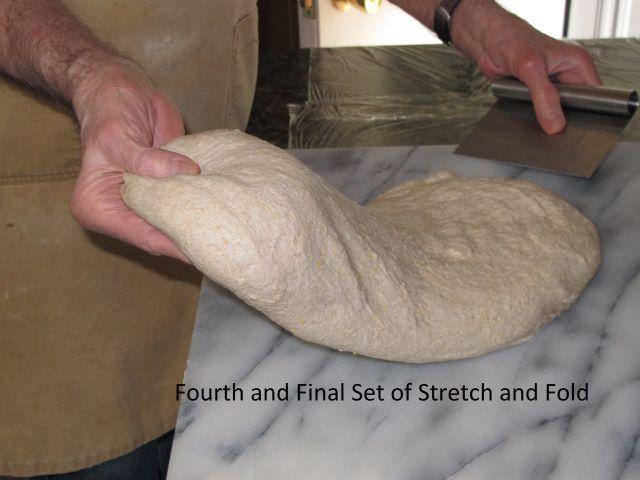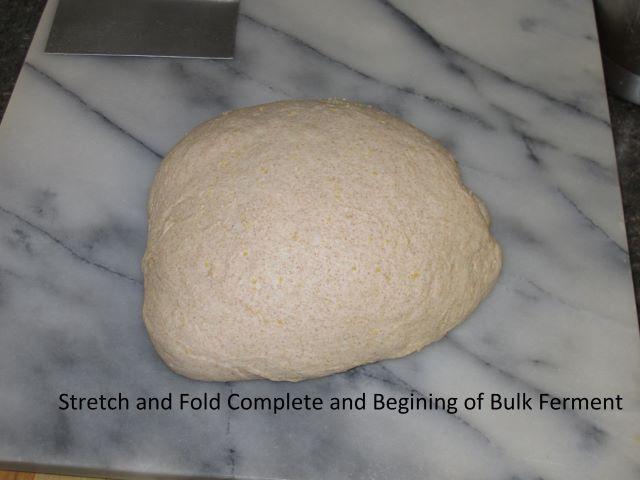-
Posts
101 -
Joined
-
Last visited
Content Type
Profiles
Forums
Store
Help Articles
Posts posted by Dave R
-
-
4 minutes ago, Cyberider said:
Thanks, Dave R! Just to confirm, that is the 4" X 9" pullman pan?
Yes. I'm using the USA 9 X 4.
Dave
-
-
 1
1
-
-
38 minutes ago, Cyberider said:
Sounds good! I'd like to try it the next time I bake if you'd care to share the formula.
Always glad to share. I may alter this later but right now I'm pretty happy with it. The yeasted starter actually has less than 1/16 t of yeast but I use a template I've made and haven't changed it yet. Just a very small amount sprinkled over the water.
If you scroll up this page on some of my responses to @PatrickTyou'll get an idea of my process. I only do two stretch and folds for the rye bread, since there's less gluten there to develop. I'll be happy to answer any questions and feel free to point out any errors I've made. I post this as a picture. I'm not sure I can post a spread sheet.
Adjust water temperature so dough after mixing is 76°. Usually start at 69°-70°.
Mix 3 min using Bosch mixer or 9 min in bread machine. Ferment covered on board for about 1 hour, turning (stretch and fols) at 30 minutes. Ferment in bulk in ‘fridge, folding to degas at 4 or 5 hours. Leave 12 to 18 hours. If baking that day, ferment about 90 minutes, folding once half way thru,, before scaling and shaping.
Take out of fridge and allow to come to room temp for about 1 or 2 hours, no need to pre shape.Pre-heat the oven to 425°.
Flatten dough, shape. Place in pan and cover with plastic wrap, allowing to rise to about 1/2" of top then remove the plastic, cover with lid and let sit for another 10 minutes. Total proof time is about 30 to 40 minutes.
When the loaf is proofed, bake 25 minutes then remove lid and bake another 10 minutes. Take out of pan and bake to a total of 55 minutes. Internal temp should be about 194
Remove from the oven and cool on a rack. Note: I'm at 7,800 feet above sea level, your final dough temp may vary.Dave
-
 1
1
-
-
I've been experimenting with my Pullman pan off and on and today I baked my first rye Pullman. Used my usual wheat pre-ferment started on Saturday, mixed the dough Sunday for an overnight cold ferment and baked this morning.
I'll have to make note of this formula because when my wife tasted it she said "Damn that's good!". I cant do any better than that!
Dave
-
 5
5
-
 2
2
-
-
@JoNorvelleWalkerThat's something I'd love to do but logistics kept me from doing it.
About 6 years ago when our oven was just about to the end of it's life cycle, my wife and I decided to get an "upscale" oven rather than the contractor grade ovens we'd had.
We live in a rural area so we drove close to two hours to one of the better appliance stores and were ready to buy when I asked about parts and repair. They only scheduled repairmen every three weeks to our area and parts were proprietary and they were not available to non-professionals. So we left without buying, but were not deterred. My wife went on line to the local community forums, and found that many families in our are were needing repairs and doing without ovens. So it was back to contractor grade ovens for us. Even though prices for parts have gone up, at least I can repair my own and be up and running in a day or two.
Dave
-
 2
2
-
-
@PatrickTI'd be happy to look at you formula and schedule . Just like shaping, time and repetition will be your best teacher.
Before you buy something expensive like a Challenger remember that you don't need that heavy top. I think @Ann_T was experimenting with lighter covers back on page 103 of this forum. If you want to verify that and you have two bread pans, put your dough in one pan, mist it with water and cover it with the other pan (upside down) for the first 15 or 20 minutes of baking. Then remove it for the remainder of the bake (no convection fan if you have one). If you have one pan larger than the other use it for the top, and be careful handling hot pans.
Dave
-
 1
1
-
-
@PatrickT sorry for the delayed response. I was outside knocking down some weeds.
I don't really use steam. I know most people have some sort of procedure for doing it, but I just give my loaves a misting before they go into the oven. That gives them enough moisture to keep the crust soft enough for a decent oven spring. I guess I'm lazy, but I don't want to spend the time trying to get my oven to do something It wasn't built to do. You can see by the picture of my hearth loaves above that I have a crisp crust but not one like you have coming out of your Dutch oven. That's why you're getting more oven spring and more open crumb on your Dutch oven bake. The dough is kept from crusting over until you remove the top.
I do think scoring will help your loaf in it's expansion and keep it from bursting on the side. I'll post a picture of how my pan loaf is scored. It's not a deep score, and you can see the surface also bursts a bit on it's own at the edges. Some of the higher hydration no-knead loaves could only be scored well if they're baked in a Dutch oven. If baked on a stone there wouldn't be enough surface tension once scored to hold the loaf together. It'd be pretty flat. Otherwise, scoring is like guiding the loaf in it's growth.
If you have any questions about my process I'd be happy to help with a formula or technique. One important thing to remember with the cold ferment especially, don't over yeast. My doughs are about 0.70 to 0.80% of the formula.
Both of the loaves you posted look good to me. I'd be happy to eat either one!
Yes, I do get up early. Just old habits but they serve me well. Keep up the great baking!
Dave
-
 1
1
-
-
@PatrickT another fine looking loaf!
The shaping looks like it went well. I've never baked in a vessel other than a loaf pan, so I don't know how much that added to the final shape, bit I'd guess that that loaf would have looked as good just baked on an oven stone. The surface tension created by shaping usually sets the tone there. I think I've said before that with shaping you're creating a dough bag to hold the ingredients. Good tension holds them better.
That brings us to scoring. The surface tension will hold in the carbon dioxide gas created in baking and causing oven spring, but the gas will find a way to escape. That's where scoring comes in. Without scoring the sides will usually split to a degree, unless there is a weakness in the shaping. The gas will take the path of least resistance. I even score my pan loaves, although it's not that necessary in that case.
Bakers can take advantage of the escaping gas to create patterns that are individual or traditional, like the pattern that you see on @Ann_T's baguettes. Sone breads, like rye have scoring side to side to help the weaker dough (less gluten in rye) hold it's shape. When I was still baking on an oven stone last year I had to score the loaves baked on the left side of the oven differently (front to back) than the loaves on the right side of the oven (side to side) because the heat was different in those areas. I did that to get consistent oven spring. Normally you want consistency, like the baguettes. I'll post a picture of my usual scoring on an oven stone, baked without steam.
When to cold ferment? When I stopped using sourdough, about 10 years ago when I retired, I started using cold proofed pre-ferments and cold proofed doughs. I generally make a yeasted starter (poolish) during the day (70° F water) let in sit at room temp for an hour and then into a 40° F 'fridge overnight. I take it out around 3 or 4 AM and it has fully developed by 1 PM and ready to me mixed into my dough. Mixed dough goes thru a series of four stretch and folds every 20 minutes for an hour and then into the 'fridge. I de-gas and fold the dough at about two hours an then again about 4 hours later. Dough comes out of the fridge at about 3 AM and warms for an hour or so, is pre shaped and rests for 30 minutes, shaped and proofs for 45 minutes or so and then into the oven and done.
This produces a loaf that is every bit as flavorful as my sourdough was and it will last un to 6 days if wrapped in plastic. We finish them sooner than that though!
Sorry to be so long winded, but you asked! Feel free to point out what I nissed or should have left out.
Dave
-
 2
2
-
 3
3
-
 1
1
-
-
Yes. Babka Muffins. They are a little more work with the braiding but finish more quickly. Definitely worth it.
Dave
-
 2
2
-
-
10 minutes ago, PatrickT said:
That looks stunning @Dave R!! Wow!
Thanks! I think I like the babka muffins I made more, but my wife is into the loaf for now.
Dave
-
-
@heidih that's a beautiful bread board! I've never been lucky enough to have that kind of history. I do, however pre-date you by 10 years. 😁
There was no osmotolerant yeast that I knew of in the late '50s when I was first working. A friend gave me some to try in the late '90s when I was adding cinnamon to some dough and not getting a good rise. Then when Hamelman's "Bread" came out he wrote about tree bark spices having a negative reaction with yeast. It was news to me. Just lately I've heard of people using osmotolerant yeast in all their doughs, sweet or not. Just wondered if you had an insight.
@PatrickT That's a good looking loaf. I wish I had some right now!
It looks like your shaping is getting to where you want it to be and the crumb looks great. I don't know enough about the bake to comment on the crust, but with the moisture content you could probably bake a little longer. I do vote for more walnuts over more craisins!
Dave
-
 1
1
-
-
27 minutes ago, heidih said:
When I used to do a lot of sweet doughs I learned that the salt balance was often the tipping flavor point. Too little and you get an unbalanced flat taste.
@heidih that's an important point to remember in just about all kitchen work. Thanks!
I have sort of an off topic question for you. When you did your sweet doughs did you use osmotolerant yeast? With the occasional sweet doughs I've made over the years I've just boosted the amount of IDY by about another half with good results. Just wondering if it's worth keeping around in the freezer for occasional use.
Dave
-
1 hour ago, PatrickT said:
@Ann_T Agree with @Dave R - gorgeous loaves as always!
I really appreciated seeing these, Dave. I'm using this technique with almost every loaf of bread I make now. More than anything, it's really helped me develop a feel for the way dough changes as it develops. I actually just showed this process to my wife this morning (working on v2.0 of the cranberry walnut bread I posted earlier). She's a ridiculously good baker - but has never tried making bread before. She was really fascinated by it. I may have to brace myself for some spousal competition! 😂
I agree with you ln that. Getting your hands on the dough is one of the best ways to know what's going right and what's going wrong with your dough. A couple of years ago I was making pizza dough and something just didn't feel right. I looked at my containers and sure enough, I'd forgotten to add the salt.
I usually collaborate with my wife on sweet doughs. I don't have a feel for how much sugar of flavoring to add. I usually put in too little
Looking forward to your next cranberry walnut loaf!
Dave
-
 1
1
-
-
@Ann_T I agree. I only mix for about 3 minutes by machine. Just to what some bakers call the "clean-up stage" where all ingredients are fully combined. I do the gluten development by hand.
I did a whole photo demo for someone on line a few years ago. I know you don't need to see them but in case someone doesn't know the benefits of the method here are the start and end pictures.
Dave
-
 5
5
-
-
@Ann_T beautiful work as usual!
Glad the FP is working for you. These days I use every tool available to make life easier, but I still like to get my hands on the dough for a few stretch and folds.
Dave
-
5 minutes ago, Smithy said:
Thanks for the reminder about Dutch Crunch bread (the name I knew it by in central California). I experimented with making it -- usually as hamburger buns -- a few years back, then got distracted and forgot about it although we liked it very much. I'll have to put that back into my repertory!
Oh, it was pointed out during an earlier discussion (starting about here, when I was rediscovering it) that some cute little girl convinced Sainsbury's to rename it from Tiger Bread to Giraffe Bread, because everyone knows tigers have stripes instead of splotches. 🙂
@Smithy thanks for that bit of information. Just another fun fact to file away and nice to know.
Dave
-
 2
2
-
-
16 minutes ago, Ann_T said:
Dave,I keep coming back to look at these muffins. What I wouldn't give for one of those with our early minute cappuccinos.
They are surprisingly easy to make. I had to take a leap of faith with the recipe because my experience with enriched doughs kept screaming at me to develop the gluten before adding the butter, but it worked. I have an old ZO that I sometimes use for small batch doughs and I just tossed the ingredients into the bucket and went back to my other doughs.
My wife is more of an internet person than I am and she has been looking at full sized Babka on the ChainBaker site, so I may be working that into the mix next. I think the muffins are more versatile for breakfast than a slice of bread, but I guess I'll find out. I'm not sure I want to use Nutella. I'm planning on mixing almond or some other nut paste (without palm oil) with cocoa powder to see how it tastes.
Dave
-
@PatrickT a job well done!
I'd never heard of that bread or crust technique until I saw it on The Spruce Eats earlier this year. All the bakers I knew when I was a kid were from Eastern Europe and I guess they didn't have a version of that style. I'm going to have to go over the recipe, but I think I've got everything but toasted sesame oil. Definitely going on my baking schedule. I'll be sure to post once I try it.
The pan seems to have worked very well for you. It's funny to me that I hadn't thought of baking in a pan for decades until my wife got me some USA pans at the end of last year. Now I love baking in loaf pans.
Thanks for posting the link and the great pictures!
Dave
-
 1
1
-
-
@PatrickT thanks for the kind words! Basically I'm just an old baker with a good memory.
And speaking of memory and your cran/walnut memory of the restaurant bread, I was wondering if they were serving you a quick bread rather than a yeasted loaf. The reason I mention that is that several years back sone of the "fine dining" places near here were serving that type of bread. That might account for the softer crumb you remember. If that's the case, adding sweetener to a quick bread doesn't present a problem. Oil would definitely soften the crumb of a yeasted loaf. Not too much to start. 1.5 to 2% of the recipe would be a good starting point. Too much will coat the gluten strands an would have to be added after you had the gluten more fully developed. More like adding butter to a brioche dough.
On to your rye bread. I think that crumb looks perfect for a good rye. One I'd certainly be happy with. I think the problem you had was with the final shaping. This is something that practice will solve. The key thing to remember is that you want surface tension on the loaf so it holds it's shape. You are basically creating a dough bag. Time will get you there and the more often you do it the better you will get at it.
It looks to me like that recipe would work in a loaf pan. If you have one, a 9"x5" pan might be best to try first just in case it's a little wet. That way it won't go over the edges. Since that recipe calls for a Dutch oven (something I've never done) you might want to try covering the pan with another inverted pan for the first 15 or 20 minutes to get the rise you would in the iron pot. Careful when you take the pan off!
Keep up the good work! Experimenting is the best way to learn, unless you want a job in a bakery.
Dave
-
 1
1
-
-
@PatrickT you certainly produced a great looking loaf! Going by the pictures, I think yours looks better than the one on The Perfect Loaf. Keep up the good work!
Like the recipe you linked said, the combination of cranberry and walnut has been around a very long time. I made my first naturally leavened dough in 1971 (Tibetan Barley Bread from "The Tassajara Bread Book") and we were using that combination back then. The problem is that even craisins can't overcome the inherent tartness of cranberries. People that like the sour end of the spectrum don't mind it, but as you know, it's still there, even with added sweetener.
Before you add any additional sweetener, which may alter the rise and also your baking schedule, consider substituting chopped figs or even dates (for extra sweetness). That combination is also traditionally very popular.
Just as a disclaimer, I ended my 40 year sourdough journey a little over 10 years ago when I retired. I found that commercial yeast along with the careful use of yeasted pre-ferments could produce the quality, long lasting loaf that I wanted while allowing me a more flexible schedule outside the home.
Dave
-
@PatrickTthank you so much! I don't normally bake sweets like this but I could see starting.
Any recommendations on recipes by ChainBaker too try?
Dave
-
Wanted to make something different for breakfast. I'm more of a whole grain person but my wife likes sweets, so I gave Babka Muffins a try and put her to work braiding. This is a version of ChainBaker's Chocolate Babka Muffins modified slightly for altitude and oven. These are really tasty. I don't think I've had that much butter in a year!
Dave
-
 7
7
-
 4
4
-
-
That's a great looking loaf to me. One any bakery would be happy to have produced.
Dave
-
 1
1
-







The Bread Topic (2016–)
in Pastry & Baking
Posted
@PatrickT great looking loaves. Love the look of that slice!
Dave